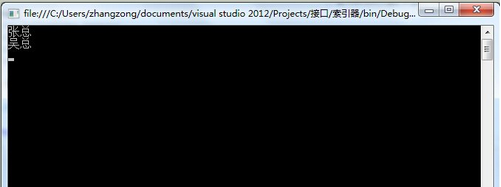C#中的索引器原理
作者:网络转载 发布时间:[ 2016/4/14 14:16:03 ] 推荐标签:测试开发技术 .NET
朋友们,还记得我们在C#语言开发中用到过索引器吗?
记得在获得DataGridView控件的某列值时:dgvlist.SelectedRows[0].Cells[0].Value;
记得在获得ListView控件的某列值时:listView1.SelectedItems[0].SubItems[0].Text;
记得在读取数据库记录给变量赋值时:result=dr["StudentName"].ToString();
记得Dictionary中根据key值来获取Value值时:dic["key"]等等
我们只知道索引器给我们解决了许多问题,带来了许多方便,但你知道它的原理所在吗?
01.C#中的类成员可以是任意类型,包括数组和集合。当一个类包含了数组和集合成员时,索引器将大大简化对数组或集合成员的存取操作。
02.定义索引器的方式与定义属性有些类似,其一般形式如下:
[修饰符] 数据类型 this[索引类型 index]
{
get{//获得属性的代码}
set{ //设置属性的代码}
}
03.索引器的本质是属性
下面我们以一个例子来了解索引器的用法和原理:
01.创建一个Test类,里面定义一个数组和一个索引器
using System;
using System.Collections.Generic;
using System.Linq;
using System.Text;
using System.Threading.Tasks;
namespace 索引器
{
public class Test
{
//01.首先定义一个数组
private string[] name=new string[2];
//02.根据创建索引器的语法定义一个索引器,给name数组赋值和取值
public string this[int index]
{
get { return name[index]; }
set { name[index] = value; }
}
}
}
02.在Main方法中通过索引器给Test类中的数组赋值
using System;
using System.Collections.Generic;
using System.Linq;
using System.Text;
using System.Threading.Tasks;
namespace 索引器
{
class Program
{
static void Main(string[] args)
{
//01.首先你得实例化Test类的对象
Test test=new Test();
//02.利用索引器给Test类中的数组赋值
test[0] = "张总";
test[1] = "吴总";
//03.打印查看效果
for (int i = 0; i < 2; i++)
{
Console.WriteLine(test[i]);
}
Console.ReadLine();
}
}
}
03.效果如下:

这样是索引器的应用
上面说到
索引器的本质是属性
是的,我们可以发现上面定义索引器的代码的IL(中间语言)是(属性的格式):

这是索引器
相关推荐

更新发布
功能测试和接口测试的区别
2023/3/23 14:23:39如何写好测试用例文档
2023/3/22 16:17:39常用的选择回归测试的方式有哪些?
2022/6/14 16:14:27测试流程中需要重点把关几个过程?
2021/10/18 15:37:44性能测试的七种方法
2021/9/17 15:19:29全链路压测优化思路
2021/9/14 15:42:25性能测试流程浅谈
2021/5/28 17:25:47常见的APP性能测试指标
2021/5/8 17:01:11













 sales@spasvo.com
sales@spasvo.com